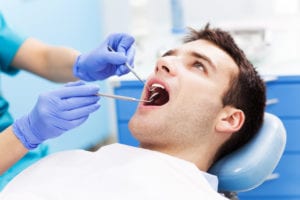Written by Angeline A. De Leon, Staff Writer. A combination of hydrogen peroxide and ozone was significantly more effective as a rapid bleaching agent for teeth than hydrogen peroxide or ozone alone.
 Ozone (O3), a colorless gas made up of three oxygen atoms, has been utilized as a therapeutic agent in medicine for over 150 years now. Ozone therapy is used to disinfect bacteria, viruses, and fungi, to improve the body’s intake of oxygen, and activate the immune system 1. In dentistry, ozone is associated with a bleaching effect on pigmented teeth and has been a popular application for tooth whitening treatments 2. Studies report that ozone by itself produces similar bleaching capacities as high concentration commercial bleaching agents such as carbamide peroxides and hydrogen peroxide (H2O2) and that when H2O2 is used in combination with ozone, bleaching results can be significantly enhanced 3. Unlike standard whitening solutions, which are commonly associated with tooth sensitivity (pain sensations caused by tooth whitening procedures) 4, the local application of ozone is also known to mitigate pain and reduce inflammation 5,6. In an exploratory clinical trial 7, researchers at the University of Jordan sought to elucidate both the clinical efficacy and the bleaching effects of ozone on pigmented teeth before and after the application of H2O2.
Ozone (O3), a colorless gas made up of three oxygen atoms, has been utilized as a therapeutic agent in medicine for over 150 years now. Ozone therapy is used to disinfect bacteria, viruses, and fungi, to improve the body’s intake of oxygen, and activate the immune system 1. In dentistry, ozone is associated with a bleaching effect on pigmented teeth and has been a popular application for tooth whitening treatments 2. Studies report that ozone by itself produces similar bleaching capacities as high concentration commercial bleaching agents such as carbamide peroxides and hydrogen peroxide (H2O2) and that when H2O2 is used in combination with ozone, bleaching results can be significantly enhanced 3. Unlike standard whitening solutions, which are commonly associated with tooth sensitivity (pain sensations caused by tooth whitening procedures) 4, the local application of ozone is also known to mitigate pain and reduce inflammation 5,6. In an exploratory clinical trial 7, researchers at the University of Jordan sought to elucidate both the clinical efficacy and the bleaching effects of ozone on pigmented teeth before and after the application of H2O2.
In a three-arm, double-blind, randomized controlled trial, a total of 45 participants, all of whom were regular patients visiting the dental clinics at the University of Jordan for bleaching treatment, were recruited for participation. Prior to and following intervention (24 hours post-treatment), tooth sensitivity was assessed using a visual analogue scale (VAS) and shade measurements were carried out from the surface of the upper right canine to that of the upper left canine using a colorimeter. Participants were randomized to one of three groups: in Group 1, upper anterior teeth were bleached using ozone (produced using a healOzone X4 device) for 60 seconds followed by 38% H2O2 for 20 minutes; in Group 2, 38% H2O2 was administered for 20 minutes followed by 60 seconds of ozone; and in Group 3, teeth were exposed to 60 seconds of just air from the ozone machine (no ozone), followed by 38% H2O2 for 20 minutes (control).
Findings indicated that while Group 2 (H2O2 followed by ozone) did not show any bleaching sensitivity, Group 1 (ozone followed by H2O2) and Group 3 (H2O2 only controls) experienced increased sensitivity following treatment (p < 0.001). All three bleaching techniques were found to enhance shade values of teeth (p < 0.001). However, ozone treatment resulted in lighter tooth shades, regardless of whether it was applied prior to or following H2O2 (p < 0.05).
Evidence from the study suggests a complimentary effect of applying ozone together with H2O2 to achieve optimal bleaching results. Not only was this combined bleach treatment associated with zero tooth sensitivity, due to the analgesic properties of ozone 8, but results suggest an effective synergistic relationship between ozone and H2O2, leading to lighter tooth shades, regardless of the sequence of ozone application. Thus, findings confirm the clinical advantage of using an ozone/H2O2 combination for effective and rapid bleaching effects. Further research is needed to determine the optimal ratio of peroxide to ozone for clinical treatment.
Source: AL-Omiri MK, Al Nazeh AA, Kielbassa AM, et al. Randomized controlled clinical trial on bleaching sensitivity and whitening efficacy of hydrogen peroxide versus combinations of hydrogen peroxide and ozone. Scientific Reports. 2018; 8: 2407. DOI: 10.1038/s41598-018-20878-0.
© Open Access This article is licensed under a Creative Commons Attribution 4.0, http://creativecommons.org/licenses/by/4.0/.
Click here to read the full text study.
Posted June 14, 2018.
References:
- Al-Omiri MK, Alhijawi M, AlZarea BK, Ra’ed S, Lynch E. Ozone treatment of recurrent aphthous stomatitis: a double blinded study. Scientific reports. 2016;6:27772.
- AL-Omiri MK, Hassan ReSA, Kielbassa AM, Lynch E. Bleaching efficacy of ozone/hydrogen peroxide versus hydrogen peroxide/ozone application. Quintessence International. 2017;48(10).
- AL-Omiri MK, Ra’ed S, AlZarea BK, Lynch E. Effects of combining ozone and hydrogren peroxide on tooth bleaching: A clinical study. Journal of dentistry. 2016;53:88-93.
- Kielbassa AM, Maier M, Gieren A-K, Eliav E. Tooth sensitivity during and after vital tooth bleaching: A systematic review on an unsolved problem. Quintessence international. 2015;46(10).
- Bocci V, Borrelli E, Zanardi I, Travagli V. The usefulness of ozone treatment in spinal pain. Drug design, development and therapy. 2015;9:2677.
- Azuma K, Mori T, Kawamoto K, et al. Anti? inflammatory effects of ozonated water in an experimental mouse model. Biomedical reports. 2014;2(5):671-674.
- Al-Omiri MK, Al Nazeh AA, Kielbassa AM, Lynch E. Randomized controlled clinical trial on bleaching sensitivity and whitening efficacy of hydrogen peroxide versus combinations of hydrogen peroxide and ozone. Scientific reports. 2018;8(1):2407.
- Clavo B, Santana-Rodriguez N, Gutierrez D, et al. Long-term improvement in refractory headache following ozone therapy. The Journal of Alternative and Complementary Medicine. 2013;19(5):453-458.

